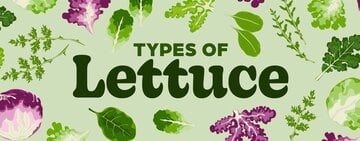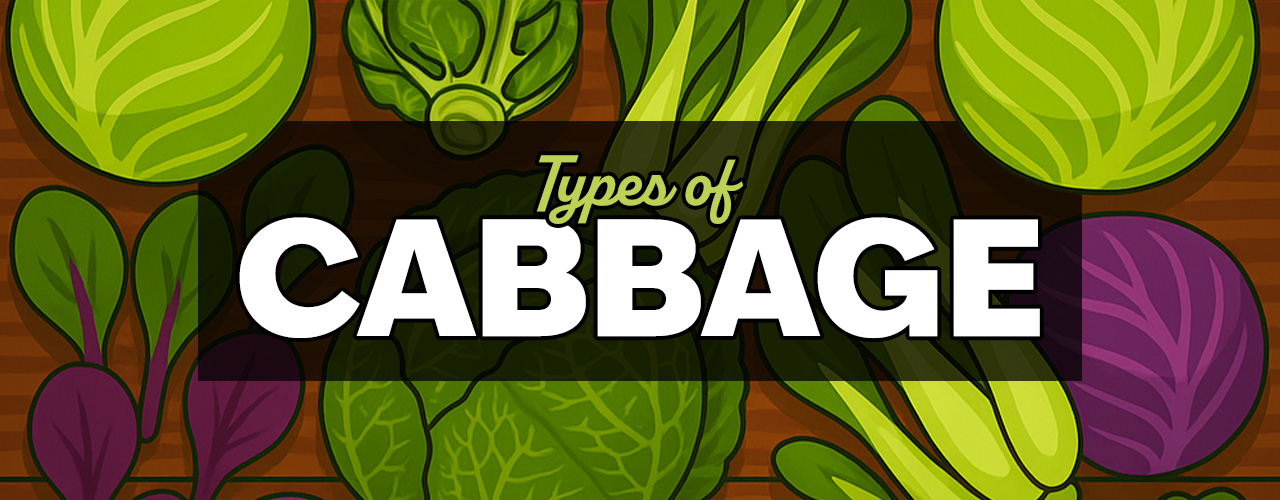
From the crisp bite of green cabbage in coleslaw to the sweetness of napa cabbage in stir-fries, understanding the differences between the various types of cabbage can elevate your menu offerings and appeal to diverse customer preferences. Whether you're looking to enhance salads, soups, or fermented dishes like kimchi, selecting the right cabbage makes all the difference in flavor and presentation. Below, we explore the key characteristics of the most popular cabbage varieties, helping chefs and restaurant operators make informed decisions that optimize their dishes and boost customer satisfaction.
Shop All Fresh CabbageWhat Is Cabbage?
Cabbage is a versatile, leafy vegetable known for its layered leaves that form dense or loose heads depending on the variety. All culinary cabbages are safe to eat, though their flavors range from pungent to mildly sweet, with textures varying from crisp to tender based on type and preparation. While most thrive in cool climates, growing seasons and regional adaptability differ, as some varieties mature quickly for spring harvests, while others withstand frost for winter availability. For chefs, cabbages offer exceptional kitchen utility, providing cost-effective volume, extended shelf life, and adaptability across raw and cooked applications.
Cabbage Types
Below, we provide an overview of the most common cabbage varieties found in commercial kitchens:
1. Green Cabbage
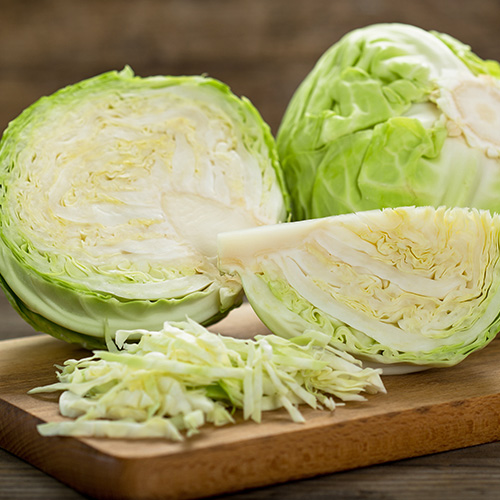
Green cabbage is the workhorse of the cabbage family, recognized by its dense, spherical head of tightly packed pale to dark green leaves. This cabbage has a crisp texture and mild pepper-like flavor that mellows when cooked. Its sturdy leaves hold up well to both raw and cooked applications, from crunchy coleslaws and fermented sauerkraut to slow-braised dishes and hearty soups. Green cabbage offers exceptional value with minimal waste, as even the outer leaves can be utilized in stocks or braises. Its versatility and affordability make it indispensable for high-volume meal prep as a base for salads, a wrapper for fillings, or a budget-friendly bulk ingredient.
- What Does Green Cabbage Look Like? Round, compact head with smooth, waxy green leaves
- What Does Green Cabbage Taste Like? Mild pepper flavor when raw, but sweetens when cooked
- Best Uses for Green Cabbage: Coleslaw, fermenting, braising, soups, and stuffed leaves
- How to Clean Green Cabbage: Remove outer leaves, quarter head to rinse between layers
- How to Store Green Cabbage: Whole heads last 2+ weeks refrigerated, store cut pieces airtight
2. Bok Choy
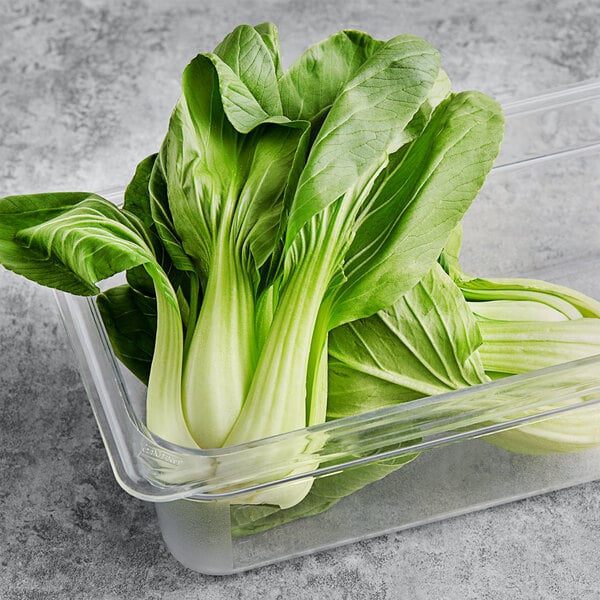
Bok choy is a leafy green vegetable distinguished by its white stems and dark green leaves, offering a mild, slightly sweet flavor with a subtle peppery note. Unlike round-headed cabbages, bok choy grows in loose clusters, making it ideal for quick cooking methods like stir-frying, steaming, or sauteing while retaining its pleasant crunch. Its versatility allows it to shine in Asian-inspired dishes, soups, and even as a nutrient-rich addition to salads or braised preparations.
- What Does Bok Choy Look Like? White stalks with dark green, spoon-shaped leaves
- What Does Bok Choy Taste Like? Mild, slightly sweet with a subtle peppery finish
- Best Uses for Bok Choy: Stir-fries, soups, steaming, braising, and salads
- How to Clean Bok Choy: Rinse under cold water, separate leaves to remove dirt
- How to Store Bok Choy: Can be refrigerated in a perforated bag for up to 5 days
3. Kohlrabi

Kohlrabi is a unique member of the cabbage family known for its bulbous stem and edible leaves. It offers a crisp texture and a mildly sweet, slightly peppery flavor reminiscent of broccoli stems. Unlike traditional cabbages, kohlrabi grows above ground with stems that can be green or purple, though the interior flesh remains pale and tender. Its firm yet juicy texture holds well in both raw and cooked applications, as it can be shredded into slaws, roasted for a caramelized bite, or pureed into soups for added depth.
- What Does Kohlrabi Look Like? Round bulb with protruding stems, green or purple skin with a white interior
- What Does Kohlrabi Taste Like? Mildly sweet, slightly peppery, similar to broccoli stems
- Best Uses for Kohlrabi: Raw in slaws, roasted, grilled, soups, or pickled
- How to Clean Kohlrabi: Peel tough outer skin, rinse under cold water
- How to Store Kohlrabi: Remove leaves, refrigerate unpeeled in a damp cloth for up to 2 weeks
4. Napa Cabbage

Napa cabbage stands out with its oblong shape, tightly packed pale green leaves, and white ribs, offering an intricate sweetness and milder flavor than traditional green cabbage. Its tender yet sturdy leaves make it ideal for both raw and cooked applications, where it softens while retaining a pleasant texture. Napa cabbage provides an efficient prep option that requires minimal trimming and delivers a refined presentation that elevates Asian-inspired dishes.
- What Does Napa Cabbage Look Like? Elongated, barrel-shaped with crinkled light green leaves and thick white stems
- What Does Napa Cabbage Taste Like? Mild, slightly sweet with a refreshing crunch
- Best Uses for Napa Cabbage: Kimchi, stir-fries, salads, soups, wraps
- How to Clean Napa Cabbage: Remove outer leaves, rinse under cold water, slice as needed
- How to Store Napa Cabbage: Wrap in a damp paper towel, refrigerate in a perforated bag for up to 2 weeks
Napa Cabbage vs Green Cabbage
Napa cabbage, with its elongated shape and crinkled, pale green leaves, offers a more delicate crunch and sweeter flavor profile compared to the dense, round head and peppery notes of traditional green cabbage. While green cabbage maintains its firm texture through prolonged cooking, napa cabbage's tender leaves wilt quickly, making it perfect for dishes where a lighter bite is desired. Visually, napa cabbage lends an elegant presentation to Asian-inspired dishes, while green cabbage provides bulk and structure for Western-style preparations.
Napa Cabbage vs Bok Choy
Napa cabbage forms tight, oblong heads with pale, crinkled leaves, offering a sweet flavor and crisp yet tender texture. On the other hand, bok choy grows in loose clusters with dark green leaves and prominent white stems, delivering a more pronounced vegetal taste with contrasting crunchy stalks and silky leaves.
Napa cabbage excels in bulk preparations like kimchi, stir-fries, and hot pot bases where its neutral sweetness absorbs flavors. Bok choy's structural contrast makes it ideal for plating, as the white stems retain bite when cooked while the leaves wilt beautifully, creating textural interest in dishes. Napa cabbage works better for fermentation and volume cooking, while bok choy shines as a quick-cooking standalone vegetable or elegant garnish.
5. Brussels Sprouts

Brussels sprouts are miniature vegetables that grow in spiral formations along thick stalks. They offer a distinctive nutty-sweet flavor when cooked properly, with a dense texture that holds up well to high-heat cooking methods. When raw, they deliver a slightly bitter punch that mellows. However when roasted, fried, or grilled, they can be transformed into a versatile ingredient for everything from hearty side dishes to trendy appetizers. Their compact size and uniform shape make them ideal for batch preparation, whether halved for roasting, shredded for slaws, or blanched for salads.
- What Do Brussels Sprouts Look Like? Small, round buds with tightly wrapped green leaves
- What Do Brussels Sprouts Taste Like? Nutty, mildly bitter when raw, but have a caramelized sweetness when cooked
- Best Uses for Brussels Sprouts: Roasting, pan-searing, shredding for slaws, frying, grilling
- How to Clean Brussels Sprouts: Trim stem ends, remove loose outer leaves, rinse under cold water
- How to Store Brussels Sprouts: Keep unwashed in ventilated containers, can be refrigerated for up to 1 week
6. Red Cabbage
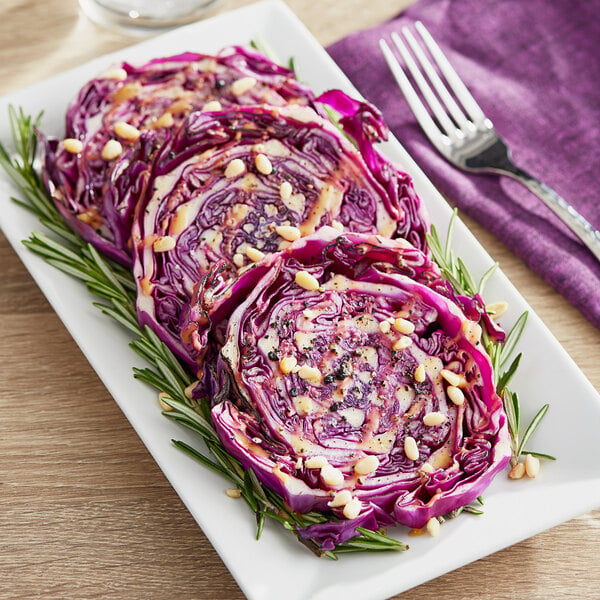
With its striking deep purple hue and tightly packed, waxy leaves, red cabbage makes a bold visual statement on any menu. When raw, it delivers a satisfying crunch and vibrant color to slaws and salads, while slow cooking brings out its natural sweetness, making it ideal for braises, pickling, or as a colorful bed for proteins. The vegetable's natural anthocyanins (which create its purple pigment) react to pH changes, allowing creative chefs to use them for dramatic color transformations in acidic or alkaline preparations.
- What Does Red Cabbage Look Like? Dense round head with smooth, deep purple-red leaves
- What Does Red Cabbage Taste Like? Earthy, slightly peppery when raw, but mellows to sweet when cooked
- Best Uses for Red Cabbage: Fermentation, braising, raw slaws, pickling, colorful garnishes
- How to Clean Red Cabbage: Remove outer leaves, quarter head to rinse between layers
- How to Store Red Cabbage: Whole heads last 2-3 weeks refrigerated, store cut pieces airtight
Red Cabbage vs Green Cabbage
The most obvious difference is color, as red cabbage’s deep purple hue provides a dramatic plate presentation, while green cabbage offers a more neutral backdrop. Red cabbage excels in applications where color retention is key like pickling, braising, or as a vibrant raw slaw. In contrast, green cabbage is preferable for traditional fermentations, bulk cooking, or dishes where a neutral flavor is desired. Red cabbage’s anthocyanin content (which creates its color) also reacts to pH changes, allowing chefs to create striking visual effects with acidic or alkaline ingredients. When cost and yield are considerations, green cabbage typically offers better value for high-volume use, while red cabbage provides unmatched visual appeal for premium dishes.
Red Cabbage vs Purple Cabbage
Despite the naming variations, red and purple cabbage are the same vegetable, as the terms are used interchangeably based on regional preferences. The vibrant leaves naturally appear more purple in hue but develop reddish tones when exposed to acidic ingredients during cooking, leading to both descriptor terms. This color-changing quality makes it invaluable for chefs creating visually dynamic dishes where pH levels can be manipulated for dramatic effect.
Napa Cabbage vs Red Cabbage
Napa cabbage’s elongated, pale green heads with crinkled leaves offer a mild sweetness and tender crunch, while red cabbage’s dense, round form with deep purple leaves delivers earthy notes and a firmer bite. The most striking difference is their behavior during cooking. Napa cabbage wilts quickly, making it ideal for fast preparations, whereas red cabbage maintains structure through prolonged cooking and its color intensifies with acidity.
Back to Top7. Savoy Cabbage

Savoy cabbage stands out with its crinkled, emerald-green leaves and softer texture, offering a more refined alternative to standard green cabbage. The tender yet resilient leaves hold their structure beautifully when cooked, perfect for wrapping fillings, layering in casseroles, or adding to soups where they impart flavor without overwhelming other ingredients. Unlike firmer cabbages, Savoy cabbage requires less cooking time, allowing for quicker prep in high-volume kitchens while delivering an elegant presentation.
- What Does Savoy Cabbage Look Like? Loose, ruffled green leaves with a crinkled texture
- What Does Savoy Cabbage Taste Like? Mild, slightly sweet with buttery undertones
- Best Uses for Savoy Cabbage: Stuffed leaves, braises, soups, stir-fries, tender slaws
- How to Clean Savoy Cabbage: Remove outer leaves, rinse under cold water, pat dry
- How to Store Savoy Cabbage: Refrigerate unwashed in perforated bags for 1-2 weeks
Savoy Cabbage vs Green Cabbage
Green cabbage forms tight, smooth-leaved heads with a crisp bite and slightly peppery flavor, while Savoy cabbage features loose, ruffled leaves with a more silky texture and sweeter taste. The most noticeable difference is structural, with green cabbage's waxy leaves holding up to aggressive cooking methods. Savoy cabbage's tender crinkled leaves are less stable and cook faster. Green cabbage is the economical choice for slaws, fermentations, and braises where texture retention matters, while savoy cabbage shines in upscale applications.
Savoy Cabbage vs Napa Cabbage
Savoy cabbage's signature crinkled, emerald-green leaves offer an airy, buttery flavor and tender structure. Napa cabbage's elongated form with pale, smooth leaves delivers a sweeter taste and crunchier bite. The visual distinction is immediate, Savoy cabbage's ruffled leaves create elegant plating opportunities, whereas napa's tight cylindrical shape yields uniform slices ideal for precise knife work.
Savoy cabbage's flexible leaves excel as natural wrappers for gourmet fillings or layered in upscale casseroles, requiring minimal prep time. Napa cabbage shines in high-speed operations, as its quick-cooking nature makes it perfect for stir-fries, while its high water content accelerates fermentation for kimchi production.
8. Choy Sum

Choy sum is a delicate leafy green distinguished by its slender stems, small yellow flowers, and tender dark green leaves, offering a mildly sweet flavor with subtle mustard-like notes. Unlike heartier cabbages, choy sum cooks in seconds, making it ideal for high-speed wok cooking, quick blanching, or gentle steaming to preserve its vibrant color and tender texture. Its versatility shines in Asian-inspired dishes, from simple garlic stir-fries to noodle bowls, while its attractive appearance makes it an elegant garnish or stand alone side.
- What Does Choy Sum Look Like? Slender light green stems with oval leaves and small yellow flowers
- What Does Choy Sum Taste Like? Mildly sweet with subtle undertones
- Best Uses for Choy Sum: Stir-fries, soups, blanching, steaming, noodle dishes
- How to Clean Choy Sum: Soak in cold water to remove grit, trim tough stem ends
- How to Store Choy Sum: Wrap in a damp paper towel, refrigerate upright for 3-4 days
Choy Sum vs Bok Choy
Flavor-wise, choy sum has subtle mustard-like notes, while bok choy is milder and slightly sweeter. While choy sum and bok choy are staple Asian greens, they differ significantly in appearance, texture, and culinary applications. Choy sum is identifiable by its slender stems, small yellow flowers, and delicate leaves, offering a tender texture ideal for quick cooking methods like stir-frying or blanching. Choy sum works best as a refined garnish or in light dishes where its flowers add visual appeal, whereas bok choy's robust structure makes it suitable for bulk preparations and center-of-the-plate applications.
9. Golden Acre Cabbage

Golden Acre cabbage is a compact, early-season variety prized for its small to medium-sized heads with smooth, light green leaves and a sweet, delicate flavor less pungent than standard green cabbage. The smaller head size makes it ideal for operations needing portion-controlled ingredients without excessive waste. Its mild taste adapts well to both raw and lightly cooked applications. Unlike larger cabbages, Golden Acre's leaves are more tender, requiring shorter cooking times for stir-fries or quick braises. For chefs seeking a gourmet twist on traditional cabbage dishes, this variety provides superior texture and sweetness without compromising the versatility expected from cabbage.
- What Does Golden Acre Cabbage Look Like? Small round heads with smooth, pale green leaves
- What Does Golden Acre Cabbage Taste Like? Sweeter and milder than standard green cabbage
- Best Uses for Golden Acre Cabbage: Fine slaws, quick stir-fries, stuffed leaves, light pickling
- How to Clean Golden Acre Cabbage: Remove loose outer leaves, rinse under cold running water
- How to Store Golden Acre Cabbage: Keep whole in refrigerator for 1-2 weeks
10. Red Acre Cabbage
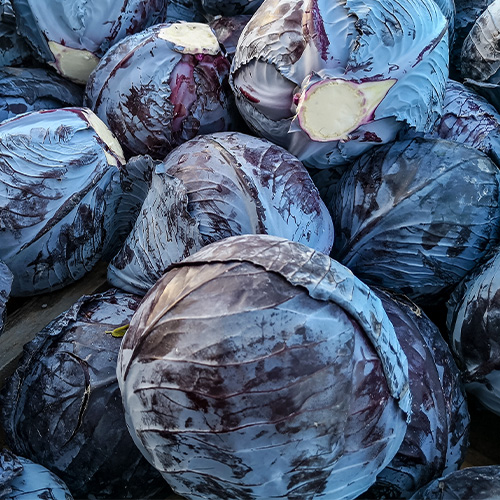
Red Acre cabbage stands out with its vibrant ruby-purple hue and compact, slightly flattened heads, offering a more tender texture and sweeter flavor profile than standard red cabbage varieties. The leaves are less fibrous than larger red cabbages, making them ideal for quick-pickling, fresh slaws, or gentle sauteing where they retain a pleasant bite without becoming tough. Its striking color intensifies when cooked with acidic ingredients, allowing chefs to create visually stunning dishes.
- What Does Red Acre Cabbage Look Like? Compact, round-flattened heads with deep reddish-purple leaves
- What Does Red Acre Cabbage Taste Like? Sweeter and milder than standard red cabbage
- Best Uses for Red Acre Cabbage: Vibrant slaws, quick pickles, sauteed sides, fermented dishes
- How to Clean Red Acre Cabbage: Peel back outer leaves, rinse under cold water
- How to Store Red Acre Cabbage: Whole heads last 3-4 weeks refrigerated in plastic wrap
Red Acre Cabbage vs Golden Acre Cabbage
The flavor profiles between the two differ significantly as Golden Acre offers a sweeter, milder taste that adapts to subtle seasonings. Red Acre brings an earthy depth that stands up to bold spices. Visually Red Acre cabbage delivers dramatic purple hues that intensify in acidic preparations, while Golden Acre cabbage's pale green leaves provide a neutral canvas for delicate flavors. The most obvious difference is their pigmentation, as Red Acre cabbage's vibrant color bleeds when cooked, making it ideal for striking pickled vegetables or colorful slaws. On the other hand, Golden Acre cabbage maintains a clean appearance suited for light-colored dishes.
Back to TopMastering the diverse world of cabbage unlocks new possibilities for cost-effective, flavorful, and visually dynamic menu development. Each variety offers distinct textures and applications that can transform dishes across culinary traditions. By strategically incorporating these versatile vegetables, whether for bulk preparation, fermentation, or premium plating, operators can enhance food costs, reduce waste, and deliver memorable vegetable-forward offerings that cater to modern dining trends.

